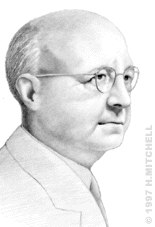Clarence Birdseye
Clarence Birdseye (1886-1956) found a way to flash-freeze foods and deliver them to the public - one of the most important steps forward ever taken in the food industry.
Born in Brooklyn on December 9, 1886, Birdseye was a biology major at Amherst College when he quit school to work as a naturalist for the U.S. government. He was posted to the Arctic, where he observed firsthand the ways of the Native Americans who lived there. Birdseye saw that the combination of ice, wind, and temperature almost instantly froze just-caught fish. More importantly, he found that when the fish were cooked and eaten, they were scarcely different in taste and texture than if they would have been fresh.
Birdseye, the biologist, saw that the fish were frozen too quickly for ice crystals to form and ruin their cellular structure. Birdseye, the businessman, saw that the public back home would gladly pay for such frozen foods if he could deliver them. He returned to New York and, in 1924, founded Birdseye Seafoods, Inc.

In the early 1900s, many people were experimenting with mechanical and chemical methods to preserve food. After years of work on his own process, Birdseye invented a system that packed dressed fish, meat, or vegetables into waxed-cardboard cartons, which were flash-frozen under high pressure (patent #1,773,079, 1930).
Birdseye now turned to marketing. He tested refrigerated grocery display cases in 1930 and entered a joint venture to manufacture them in 1934. In 1944, Birdseye's company began leasing refrigerated boxcars to transport the frozen foods by rail nationwide. This made national distribution a reality and Birdseye a legend. Unfortunately, Birdseye died October 7, 1956. However, his contributions still were relevant. As of 2009, Birdseye's contributions became an asset of Pinnacle Foods, Inc.
Today, we especially appreciate that Birdseye's process, still basically in use, preserves food's nutrients as well as its flavor. In fact, we can say that Clarence Birdseye has indirectly improved both the health and convenience of virtually everyone in the industrialized world.
For more information, visit the Birdseye website.
For an overview of the history of frozen foods, visit the American Frozen Foods Institute website.


